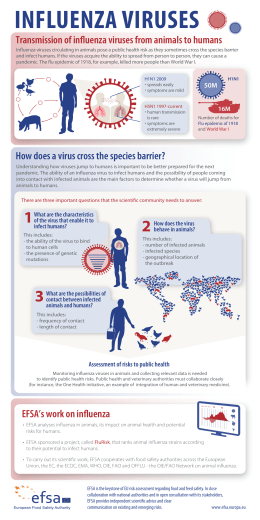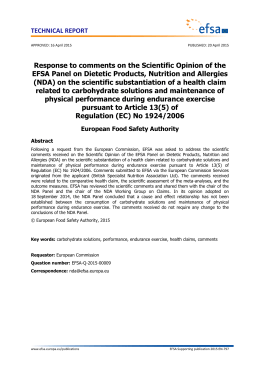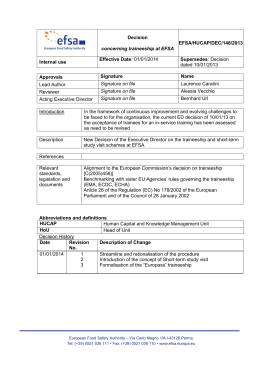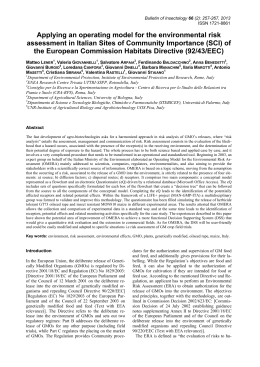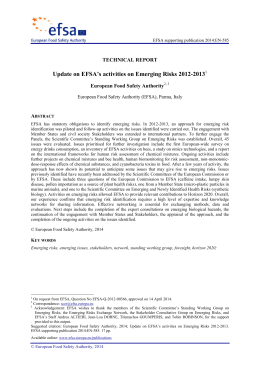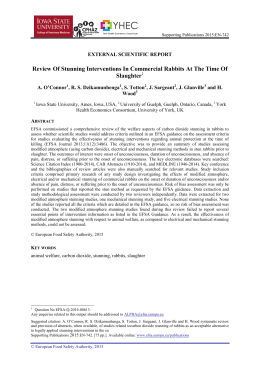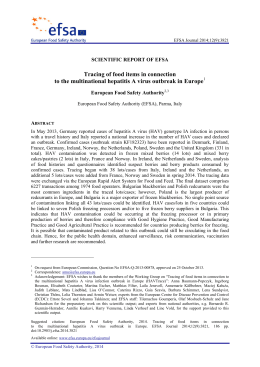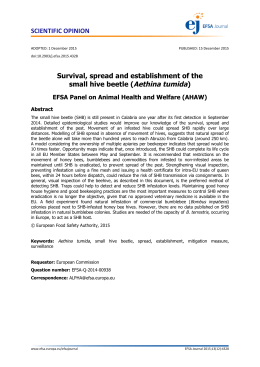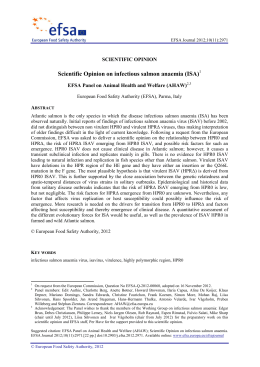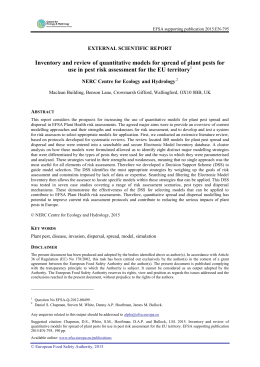ADVISORY FORUM AND SCIENTIFIC COOPERATION Guidelines on the Management of the List of Competent Organisations According to Article 36 of EFSA’s Founding Regulation1 European Food Safety Authority European Food Safety Authority (EFSA), Parma, Italy BACKGROUND Article 36 of EFSA’s Founding Regulation2 provides the legal basis for cooperation between EFSA and designated Member State competent organisations. The implementing rules on the establishment of the network and its activities are described in Commission Regulation (EC) No 2230/20043. In line with these regulations, a list of competent organisations, capable of assisting EFSA in meeting its aims and objectives, was adopted by EFSA’s Management Board in December 2006 (the “Article 36 List”), based on designations by Member States. Organisations on the List can apply to calls for proposals for EFSA projects, which are financially supported in the form of grants. The redaction of the Article 36 List is a complex procedure involving both EFSA and the Member States. The entries in the Article 36 List are managed by EFSA to ensure that the List is fit for purpose, meaning i.a. to ensure that: • The organisations inserted in the List fulfil the criteria foreseen by Article 1 of the Commission Regulation 2230/2004; • The List is kept up-to-date; • The presentation of the organisations’ names on the List is clear and consistent. The experience gained since the establishment of the List in 2006 has indicated that there is a need to develop guidelines concerning the practises followed by EFSA, Member States and (potential) competent organisations in managing the Article 36 List. OBJECTIVES The objective of this guidance document is to provide a reference for all involved actors, to ensure that the Article 36 List is kept up-to-date and functional, and that it covers the required expertise. This can further enhance the efficiency of Article 36 cooperation activities by providing guidance in the: i) The way in which Member States and EFSA check that potential organisations comply with the formal criteria stipulated in Commission Regulation (EC) No 2230/2004; ii) The presentation of the names of organisations on the List. The present guidelines are not an interpretation of the relevant regulation; they aim only to give guidance on the practical procedures for the management of the List. 1 On request from EFSA, Question No EFSA-Q-2011-00179, Report No EN-292, vers.2 approved on 17 September 2012, updated in November 2015. 2 Regulation (EC) No 178/2002 of the European Parliament and of the Council of 28 January 2002 laying down the general principles and requirements of food law, establishing the European Food Safety Authority and laying down procedures in matters of food safety (OJ L 31, 1.2.2002, p. 1–24). 3 Commission Regulation (EC) No 2230/2004 of 23 December 2004 laying down detailed rules for the implementation of European Parliament and Council Regulation (EC) No 178/2002 with regard to the network of organisations operating in the fields within the European Food Safety Authority’s mission (OJ L 379, 24.12.2004, p. 64–67). © European Food Safety Authority, 2012 Guidelines on the Management of the Article 36 List TABLE OF CONTENTS Background............................................................................................................................................ 1 Objectives .............................................................................................................................................. 1 Table of contents.................................................................................................................................... 2 Procedures.............................................................................................................................................. 3 1. Designation of organisations.......................................................................................................... 3 1.1. Practical process for new designations ................................................................................... 4 1.2. Guidance to fill in the questionnaire and to provide supporting documentation .................... 5 1.2.1. General information section (questionnaire section 2.1) .................................................... 5 1.2.2. Description of the organisation section (questionnaire section 2.2)................................... 5 1.2.3. Fields of competence (questionnaire section 3).................................................................. 6 1.3. Guidance on how to determine organisations’ compliance with criteria ................................ 6 1.3.1. Criterion 1:.......................................................................................................................... 6 1.3.2. Criterion 2:.......................................................................................................................... 7 1.3.3. Criterion 3:.......................................................................................................................... 8 1.3.4. Criterion 4:.......................................................................................................................... 8 2. Updating organisations’ profiles .................................................................................................... 9 2.1. Practical process of updating organisations’ profiles.............................................................. 9 3. Withdrawal of designated organisations from the List ................................................................ 10 4. Review of the Article 36 List ....................................................................................................... 11 5. Presentation of organisations on the List ..................................................................................... 11 5.1. Name of organisations .......................................................................................................... 11 5.2. Entries in the List .................................................................................................................. 11 Appendix/Appendices.......................................................................................................................... 13 A. Tasks and responsibilities of various actors................................................................................. 13 i. Responsibilities as stipulated in regulation .......................................................................... 13 ii. Proposed tasks ...................................................................................................................... 14 B. Suggestions for the designation/Assessment process by organisations and Member States........ 16 C. Information about “legal entities pursuing public interest objectives” ........................................ 17 2 Guidelines on the Management of the Article 36 List PROCEDURES To facilitate the management of the Article 36 List, EFSA has set up and implemented operational procedures in collaboration with the Member States, particularly for: • The maintenance and updating of the List, including the designation of new potentially competent organisations, the assessment of (potentially) competent organisations on the List, the updating of organisations’ profiles and the removal of organisations from the List; and • The presentation of the organisations’ names on the List. 1. Designation of organisations According to Commission Regulation (EC) No 2230/2004, organisations for the Article 36 List need to be “designated by the Member States on the basis of criteria covering scientific and technical competence, efficiency and independence” (Recital (3)); the criteria are indicated in Article 1 of the Regulation. When designating, “Member States shall forward (…) the names and details of the designated organisations, evidence that they comply with the criteria set out in paragraph 1, and details of their specific fields of competence. In particular, (…) Member States shall forward the names and details of the competent organisations in the field of safety assessment of genetically modified foods and feeds”. “In cases where it is a specific part of the designated organisation (…), this shall be stipulated by the Member States” (Article 1 (2)). In order to facilitate the designation process, EFSA has developed a questionnaire (available online on the Article 36 Organisations Database (Art36-DB)), to obtain information on each potentially competent organisation. The questionnaires help potential competent organisations to provide necessary information. They also support Member States (and later also EFSA) to determine whether the organisations comply with the formal criteria set under Commission Regulation (EC) No 2230/2004. Member States can formally designate the organisations for the List to EFSA, via their respective Permanent Representation / Mission in Brussels, by referring to the filled-in questionnaires and all other relevant documents in the Art36-DB in the designation letters. When determining which organisation to designate, the following should be considered: • A designated organisation must be a legal entity4, i.e. an organisation which can enter into an agreement with EFSA; if parts of bigger organisations are designated, these parts must be legal entities in themselves; • A designated organisation must be a national (as opposed to international) organisation; • A designated organisation should be able to carry out necessary tasks itself, including administrative and scientific tasks5; • In case the designated organisation has the relevant competence in its specific part(s) (e.g. a Department, Faculty) of a bigger organisation (e.g. a University), the application should specify the legal entity and only additionally its parts that are competent in EFSA’s field of work. The presentation of the organisation’s name on the List is at legal entity level (see section 5 below). Since Commission Regulation (EC) No 2230/2004 only specifies “Member States”, without giving an indication on individual players at national level, it is left to the Member States to organise the process 4 Legal entity or body having legal personality: an association, corporation, partnership, proprietorship or trust that has legal standing in the eyes of law. A legal entity has the legal capacity to enter into agreements or contracts, assume obligations, incur and pay debts, sue and be sued in its own right, and to be held responsible for its actions. 5 Important consideration, as in order to be eligible to receive EFSA grants, designated entities on the List may only work together in consortia with other designated entities, and NOT with non-designated organisations/parts of an organisation. 3 Guidelines on the Management of the Article 36 List at national level. Several Member States have developed such practices involving EFSA’s Advisory Forum Members and Focal Points6. 1.1. Practical process for new designations The currently established practical process to designate new organisations for inclusion in the Article 36 List is as follows: 1. The Advisory Forum Member/Focal Point can identify an organisation in its country as a potential Article 36 organisation, or an organisation itself can signal interest to the Focal Point or directly to EFSA. In the latter case, the organisation is put in contact with the respective Focal Point of that country, since the Focal Points provide support and advice in the process of designation of candidate organisations in their countries; 2. The organisation first registers on the online Article 36 Organisations Database7 (Art36-DB) as guest user; 3. The guest user fills in the online questionnaire on behalf of the organisation, indicating at least one contact person, and submits it electronically; 4. EFSA pre-screens the online questionnaire submitted via the Art36-DB; 5. If information is missing or clarification is needed, EFSA sends “the update request” directly to the contact person of the organisation and informs the Focal Point accordingly; 6. Once the submitted information is complete, EFSA informs the Focal Point; 7. The Member State8 then checks the information of the organisation against the criteria stipulated in Commission Regulation (EC) No 2230/2004 – the assessment by the Member State is particularly important due to the various languages and national legislations in place; 8. If the outcome of the check by the Member State is positive, the Focal Point contacts the Permanent Representation / Mission to the EU in Brussels; 9. The Permanent Representation / Mission formally designates the organisation for inclusion in the Article 36 List by submitting the designation letter to EFSA by e-mail (on condition as specified here below), copying the European Commission, and indicates, whether it is a specific part of the designated organisation that has the ability and capacity to operate in a network and/or perform the tasks which may be entrusted to them by EFSA 9; To be able to accept MS designation letters sent only via e-mail, it is important that: o the designation letter is duly signed by the authorised person of the Permanent Representation / Mission to the EU in Brussels, o the e-mail message is sent out from an official e-mail address of the Member State / Permanent Representation, o the letter includes a reference to the online questionnaire and its uploaded supporting documents in the Art36-DB, specifying: the organisation’s unique P.ID (parent identification number), the organisation’s name as in its relevant questionnaire, the date of submission of the organisation’s latest relevant questionnaire, the Member State / Permanent Representation office keeps the original document for 5 years (a requirement for EC/EFSA auditing purposes); 6 The list of Focal Points and their contact details are available on EFSA’s website: http://www.efsa.europa.eu/en/fp/fpmembers.htm 7 http://www.efsa.europa.eu/art36/registration 8 As indicated in Commission Regulation (EC) No 2230/2004 (see Annex A.i.); in practice it could be done e.g. by Advisory Forum Members or Focal Points or another body/structure (created) for this purpose (see Annexes A.ii. and B.) 9 See Article 1(2), paragraph 3 of Commission Regulation (EC) No 2230/2004 for further details. 4 Guidelines on the Management of the Article 36 List 10. EFSA checks the evidence provided by the Member State to ensure the organisation meets the criteria stipulated in Commission Regulation (EC) No 2230/2004 and prepares a proposal for the EFSA Management Board on the inclusion/non-inclusion of the organisation on the List; 11. EFSA’s Management Board decides on inclusion/non-inclusion of the organisation on the List; 12. EFSA informs the Permanent Representation / Mission, the Focal Point as well as the organisation concerned of the outcome of the Management Board’s decision and publishes the updated Article 36 List on EFSA’s website, if appropriate. 1.2. Guidance to fill in the questionnaire and to provide supporting documentation This chapter provides guidance on how to fill-in the online questionnaire on the Article 36 Organisations Database (Art36-DB), which is password-restricted. The Terms of Use 10 for the Art36DB and a User Guide are available on the application page, once logged into the Database. To facilitate the designation process and handling of information, a separate questionnaire is needed for each designated organisation. The information given in the questionnaire should refer to the entire legal entity as the designated organisation, specifying its part(s) relevant to EFSA`s remit (under the Mission and Tasks parts of the questionnaire). The following paragraphs give guidance on filling-in the questionnaire. 1.2.1. General information section (questionnaire section 2.1) Designated organisations must be legal entities (Commission Regulation (EC) No 2230/2004), i.e. organisations which can enter into an agreement with EFSA. Thus, in the questionnaire, the “Name of the organisation” and the “Name of Legal entity” would be the same. Section 5 gives further information on how the entries in the List should be organised. Organisations have the possibility to nominate one or more contact person(s) in their questionnaires. The contact person of a designated organisation has two functions: i) To disseminate all relevant information to all actors within the organisation (e.g. if an entire university is designated, the information may need to be sent to all departments, etc); and ii) To keep the questionnaire up-to-date, meaning to notify EFSA via the questionnaire on all changes. Thus, the contact person should be in a position to reach all relevant actors within the organisation and be informed of changes relevant for the questionnaire, in order to update it immediately. If an organisation decides to nominate several contact persons, one main contact person should be indicated and the functions of all persons should be specified. Giving a corporate e-mail address for the (main) contact person for an organisation can be very advantageous, as more than one person could access the mailbox and act upon any correspondence, reducing action time. Furthermore, it allows the organisation to access the questionnaire even if the (main) contact person has left the organisation. 1.2.2. Description of the organisation section (questionnaire section 2.2) When indicating the status and function of the organisation, it is possible to mark several entries in the questionnaire (governmental, public, foundation, private, part of a network, others). For example, a private university would tick the box “University / Academic institution/organisation” and “Private organisation”; additional information can be provided when ticking the “Other” box. Evidence is needed which shows that the designated entity pursues public interest objectives. Public legal acts establishing the entity in question can be submitted, or any other official document attesting 10 available once logged in under: https://art36.efsa.europa.eu/art36web/search_general?wicket:interface=:5:search:tou.link:expertUserguidePdf::IResourceListener:: 5 Guidelines on the Management of the Article 36 List the establishment of the entity, clearly indicating that it pursues public interest objectives. Appendix C gives further information and guiding elements on this item. The questions asking whether an organisation is fully or partially dependent of funding from the private sector or Non-Governmental Organisations (NGOs), refer to the designated entity’s annual budget and whether this (fully, or in part) comes from the private sector or NGOs. Further, a designated entity is asked to indicate its annual budget, as well as the percentage it receives from non-governmental resources. In the free text under “Budget comments” the designated entity should indicate what proportion of the percentage of non-governmental resources comes from public sources and the proportion from private sources, providing further details for each. In order to show that a designated entity has rules and procedures which ensure that a task entrusted to it by EFSA can be performed with independence and integrity, supporting documents such as staff regulations, legal acts establishing the organisation, internal procedures such as training plans etc. could be submitted. If a designated entity has accredited or certified working procedures, the free text field should be used to indicate the type of accreditation/certification (e.g. ISO 9001:2008 or OECD/GLP) and who awarded it (e.g. the national accreditation board). 1.2.3. Fields of competence (questionnaire section 3) This part is self-explanatory, as designated entities just need to tick the appropriate fields of competence. 1.3. Guidance on how to determine organisations’ compliance with criteria This chapter provides guidance to check the information given in the questionnaire and supporting documents based on Commission Regulation (EC) No 2230/2004, which specifies the criteria which “the competent organisations designated by the Member States in accordance with Article 36(2) of the Regulation (EC) No 178/2002 shall meet” (Article 1(1)). In summary, the following items, stated in the regulation, need to be met by a designated entity11, and are assessed using the information indicated below12: 1.3.1. Criterion 1: Organisations must carry out scientific and technical support tasks in the field within EFSA’s mission The check is based on information from: • The questionnaire, including: o o o Description of which tasks, corresponding to EFSA’s mission, the designated entity could fulfil; Fields of competence of the designated entity13; Publications in scientific peer-reviewed journals14. • Other documents, as: o The mission statement of the designated entity – gives information on the remit and tasks of the organisation. 11 For full text refer to Article 1 of Commission Regulation No 2230/2004. Items/information indicated in the text below, used to check whether an organisation meets the criteria given in Commission Regulation (EC) No 2230/2004, is not exhaustive and may vary on a case-by-case basis. 13 At least one box in the questionnaire needs to be ticked. 14 A reasonable number of publications in the indicated fields of competence should have been indicated in the questionnaire; it is important to note that organisations may have a number of relevant documents, which, however, are not published in peer-reviews journals. 12 6 Guidelines on the Management of the Article 36 List If checking this information reveals that the designated entity is working in the area of EFSA’s remit, the criterion can be considered as met. 1.3.2. Criterion 2: Organisations must be legal entities pursuing public interest objectives The check is based on information, including, from: • The questionnaire, as: o the “status and function of the organisation” (i.e. whether it is a university, governmental organisation, public, private, foundation etc.)15; • Evidence that an organisation is a legal entity – e.g. resolution, law, decree or decision establishing the entity in question, or any other official document attesting the establishment of the entity by the national authorities (for public entities); VAT registration document if applicable, or any official document (e.g. official gazette, company register) showing the name of the legal entity, the address of the head office and the registration number given to it by the national authorities; • Indication that the designated entity pursues public interest objectives by looking at the following guiding elements: o Evidence that the designated entity meets needs in the general interest16, not having an industrial or commercial character - e.g. public legal act establishing the entity in question; any other official document attesting the establishment of the entity, clearly indicating that it pursues public interest objectives; statute of the designated entity from where to analyse inter alia the exact mission, purpose, activities, and the authoritative power of the designated entity; annual report indicating the activities carried out by the designated entity; and o Evidence that the designated entity is financed, for the most part, by bodies governed by public law (i.e. public finances received by the entity must exceed 50%) – annual budget and funding sources indicated in the questionnaire (including % funding from non-governmental sources and the proportion of public and private resources). The criterion, that an organisation must be a legal entity, can be considered met if the necessary documentation is provided. Regarding “pursuing public interest objectives”, the evaluation will be done on a case-by-case assessment, based on all information and evidence provided in that context. Appendix C gives more detailed information and guiding elements for this criterion. The organisational arrangements of the organisations must include specific procedures and rules ensuring that any tasks entrusted to them by EFSA will be performed with independence and integrity The check is based on information, including, from the questionnaire, including: • Indication whether the designated entity is fully or partially dependent on funding from the private sector or NGOs with a specific interest in EFSA’s mission17. • Indication whether the designated entity accepts grants from the private sector or NGOs 17; 15 Organisations may tick more than one box, since they may fall into several of the listed categories/types. It needs to be noted that the concepts of ‘pursuing public interest objectives’ and ‘needs in the general interest’ are different, however, in the absence of a clear definition of ‘pursuing public interest objectives’ in the applicable legal framework, criteria identified in the context of determining ‘needs in the general interest’ are being used as guiding elements in screening organisations against the ‘pursuing public interest objectives’ criterion set out in Commission Regulation (EC) 2230/2004 (more detailed information is given in Appendix C). 17 If “yes” is ticked in the questionnaire, should have a closer look at the budget of the designated entity. 16 7 Guidelines on the Management of the Article 36 List • Annual budget of the designated entity18 with indication of % from non-governmental sources (and the proportion of public and private resources); • Procedures, rules and other measures which ensure independence and integrity of the designated entity and its staff – e.g. declaration of interest policy for staff, training on integrity19; • Indication of the existence of legal obligations for staff and experts to maintain confidentiality – e.g. a part in the staff regulation or an extra declaration of maintaining confidentiality, which need to be signed by staff20. The evaluation against this criterion will be done on a case-by-case assessment, based on the information provided in the questionnaire under the points mentioned above. 1.3.3. Criterion 3: Organisations must possess a high level of scientific or technical expertise in one or more field(s) of EFSA’s mission The check is based on information, including, from the questionnaire, including: • Indication of the number of scientific and support staff and number of years of experience of scientific staff working for the designated entity21; • Publications in scientific peer-reviewed journals and scientific competence of the organisations22; • Number of years the designated entity has been active in the fields of expertise23; • Accreditation or certification of working procedures indicated – if accredited or certified, the type should be indicated (e.g. ISO 9001:2008 or OECD/GLP) and by whom (e.g. the national accreditation board); • Acceptance of external assessment – external assessment could, e.g., be external auditing24; • Declaration of the fields of competence of the designated entity25. 1.3.4. Criterion 4: Organisations must have the capacity to operate in a network of organisations on the List, actively cooperating in activities in the field within EFSA’s mission, and/or organisations must have the capacity to perform efficiently the types of tasks referred to in Article 4 of the Regulation 18 The designated entity should have a sufficiently large capacity to carry out a project. If “no” is ticked in the questionnaire, should check directly with the organisation how independence and integrity are ensured. 20 If “no” is ticked in the questionnaire, should check directly with the organisation how confidentiality is ensured, particularly with regard to potential projects with EFSA. 21 A reasonable number of staff is needed in the indicated fields of competence. 22 A reasonable number of publications in the indicated fields of competence should have been indicated in the questionnaire; it is important to note that organisations may have a number of relevant documents, which, however, are not published in peer-reviews journals. 23 The number of years needed should be reasonable compared to other organisations working in the same field. This will depend on the subject. 24 If “no” is ticked in the questionnaire, one should check directly with the organisation how a high level of expertise is ensured; NB: assessment will need to be external if the organisation can show accreditation or certification. 25 At least one box should be ticked. 19 8 Guidelines on the Management of the Article 36 List The check is based on information, including, from the questionnaire, including: • Indication of experience in working in national/international expert networks of organisations; • Indication of the availability of materials and modern means of electronic document exchange and communication – e.g. description of relevant IT tools; • Indication of the capacity to give high priority to specified EFSA projects26; • Annual budget of the designated entity27 with indication of % from non-governmental sources (and the proportion of public and private resources); • Information on the number of scientific and support staff and number of years of experience of scientific staff working for the designated entity28; • Publications in scientific peer-reviewed journals and scientific competence of the designated entity29; • Number of years the designated entity have been active in the fields of expertise30; • Declaration of the fields of competence of the designated entity31; • Indication of the existence of working procedures (e.g. SOPs) in writing, which are periodically reviewed32; • Acceptance of external assessment – external assessment could, e.g., be external auditing32. 2. Updating organisations’ profiles Keeping the information of organisations up-to-date is important to ensure e.g. that the organisations can be contacted by EFSA, the Focal Point, or other competent organisations. Organisations shall immediately update their profiles (questionnaires) on the Art36-DB when changes occur and inform EFSA and the Member State accordingly. The changes can be categorised as: 1. technical changes (i.e. they have no impact on the formal criteria for inclusion stipulated in Commission Regulation (EC) No 2230/2004; e.g.: change of contact person or contact details; minor changes in areas of competence); or 2. substantial changes (i.e. they have a potential implication on the formal criteria; e.g.: changes to the structure (e.g. mergers of organisations), funding or competence of the organisation; changes in staff regulation or fundamental changes of working procedures. Member States may also request the organisations on the List (via the Advisory Forum/Focal Points), at regular intervals, to update their profiles or to confirm that their profile information is up-to-date. 2.1. Practical process of updating organisations’ profiles The process to update the information in their profiles (questionnaires) is laid down in a Decision of EFSA’s Management Board33. 26 If only first box (short-term activities) is ticked, this issue could be checked with the organisation. The designated entity should have a sufficiently large capacity to carry out a project. 28 A reasonable number of staff is needed in the indicated fields of competence. 29 A reasonable number of publications in the indicated fields of competence should have been indicated in the questionnaire; it is important to note that organisations may have a number of relevant documents, which, however, are not published in peer-reviews journals. 30 The number of years needed should be reasonable compared to other organisations working in the same field. This will also depend on the subject. 31 At least one box should be ticked. 32 If “no” is ticked in the questionnaire, should check directly with the organisation how the capacity to perform efficiently is ensured. 33 Management Board document: mb 18 12 08 item 8 doc 6b - Update on Art. 36 list of organisations 27 9 Guidelines on the Management of the Article 36 List If an organisation included on the Article 36 List needs to update the information in its profile (questionnaire) on the Art36-DB: 1. The contact person of the organisation updates the existing online questionnaire on the Art36DB34 and submits it; 2. EFSA pre-screens the changes made to the existing online questionnaire, checking whether all necessary information is available and whether the submitted changes are technical or substantial changes; 3. EFSA informs the organisation and the Focal Point if further information is needed, and if changes have been identified as being substantial (see indication above), as these need to be notified by the Permanent Representation / Mission. The process continues as follows, depending on the nature of the change: For technical changes (can be processed directly, after submission, provided all necessary information is available): 4. EFSA’s Executive Director can adopt the changes in a Decision of the Executive Director; and 5. EFSA informs the organisation concerned of the outcome via the Art36-DB, as well as EFSA’s Management Board at its next meeting; For substantial changes (need to be submitted to EFSA by the Permanent Representation / Mission): 4. The same process is applied as for new designations (see Section 1.1). 3. Withdrawal of designated organisations from the List Commission Regulation (EC) No 2230/2004 states that “[w]here designated organisations no longer meet the criteria set out in paragraph 1, Member States shall withdraw their designation and immediately inform the authority, with a copy to the Commission, accompanied by the relevant evidence” (Article 1(1)). In any case, organisations shall immediately inform the Member State if substantial changes to the organisation occur, which may lead to the organisation no longer meeting the criteria stipulated in Commission Regulation (EC) No 2230/2004. The practical process to withdraw the designation of an entity is as follows: 1. If a Member State (e.g. the Advisory Forum Member / Focal Point) recognises, e.g. during the process of reviewing the List, or receives information that a designated entity no longer meets the formal criteria, it informs EFSA and the respective Permanent Representation / Mission accordingly; 2. The Permanent Representation / Mission sends the withdrawal of designation, accompanied by the relevant evidence/reason, to EFSA by e-mail, copying the European Commission; 3. EFSA’s Executive Director amends the Article 36 List; 4. EFSA informs the Permanent Representation / Mission, the Focal Point concerned, and the organisation, if appropriate, of having deleted the organisation from the List, as well as EFSA’s Management Board at its next meeting; and 5. EFSA publishes the amendment of the Article 36 List on its website. 34 http://www.efsa.europa.eu/art36 10 Guidelines on the Management of the Article 36 List 4. Review of the Article 36 List According to Article 1(3) of Commission Regulation (EC) No 2230/2004, “Member States shall review the list of organisations they have designated regularly, and at least every three (3) years.” It was indicated in the Management Board meeting in December 2008 that a renewal of the Article 36 List should not be fixed. Thus, the review and updating should be done by the Member States and organisations, respectively, throughout the year, as appropriate. Following a more formalised review of the Article 36 List, once a year: • • 5. EFSA may remind the organisations on the List to check that the information in the organisations’ profiles (questionnaires) is still up-to-date and inform Focal Points accordingly to ask them to facilitate the process; and EFSA may request the Member State (via the Advisory Forum/Focal Points) to check the List as indicated above and to confirm that the List and organisations’ profiles (questionnaires) are up-to-date. Presentation of organisations on the List Over the years, efforts have been made, mainly in collaboration with the Focal Points, to harmonise the presentation of the entries on the List. The experience gained indicates that the development of additional guidance would be very useful to ensure further harmonisation, which would impact on the effectiveness of networking under Article 36. 5.1. Name of organisations The name of an organisation currently appears on the List in the same way as it has been designated by the respective Member State, i.e. how the organisation’s name is given in the organisation’s questionnaire. Thus, to ensure an understandable presentation of the organisations’ names on the published List, the following points should be followed: • Check that the “name of the designated organisation” and the “name of legal entity” in the questionnaire are equal, since a designated organisation must be a legal entity (even if it is a part of a bigger organisation); • Give the full name of the organisation and not only the acronym (name could be followed by acronym in brackets); • Provide the name in English; if a Member States wishes to also include the name in the original language, it could be included in brackets after the English name and before the acronym. 5.2. Entries in the List In accordance with giving the names of the organisations as specified above, the entries on the List would e.g. look as follows: 1. National Veterinary Institute35; 2. Finnish Food Safety Authority (EVIRA)36 3. Federal Environment Agency (Umweltbundesamt, UBA)37 For governmental offices (i.e. ministries), also the parts with competencies in the field of EFSA’s remit are listed, as indicated in their questionnaires, e.g.: 35 Name of organisation in English; Name of organisation in English, followed by acronym in brackets. 37 Name of organisation in English, followed by name in original language and then the acronym. 36 11 Guidelines on the Management of the Article 36 List Ministry of Rural Development and Food, including: o Directorate of Plant Produce Protection o Food Hygiene Institute of Athens o Food Hygiene Institute of Thessaloniki. 12 Guidelines on the Management of the Article 36 List APPENDIX/APPENDICES A. TASKS AND RESPONSIBILITIES OF VARIOUS ACTORS i. RESPONSIBILITIES AS STIPULATED IN REGULATION The following table lists the actors and their responsibilities as stipulated in the European Parliament and Council Regulation (EC) No 178/2002 and Commission Regulation (EC) No 2230/2004. Actors Responsibilities Member States • “it is essential for [organisations] (…) to be designated by the Member States on the basis of criteria covering scientific and technical competence, efficiency and independence” (Regulation (EC) No 2230/2004, Recital (3)); • “Member States shall forward to the Authority, with a copy to the Commission, the names and details of the designated organisations, evidence that they comply with the criteria set out in paragraph 1, and details of their specific fields of competence. In particular, for the purposes of application of Articles 6(3)(b) and 18(3)(b) of Regulation (EC) No 1829/2003, Member States shall forward the names and details of the competent organisations in the field of safety assessment of genetically modified foods and feeds” (Regulation (EC) No 2230/2004, Article 1(2), paragraph 1); • “In cases where it is a specific part of the designated organisation (…)”, which has the competences of the designated organisation “this shall be stipulated by the Member States” (Regulation (EC) No 2230/2004, Article 1(2), paragraph 3); • “Where designated organisations no longer meet the criteria set out in paragraph 1, Member States shall withdraw their designation and immediately inform the authority, with a copy to the Commission, accompanied by the relevant evidence” (Regulation (EC) No 2230/2004, Article 1(3), paragraph 1); • “Member States shall review the list of organisations they have designated regularly, and at least every three (3) years” (Regulation (EC) No 2230/2004, Article 1(3), paragraph 2). EFSA • “The Authority shall ensure that the organisations designated by the Member States comply with the criteria set out in Article 1(1)” (Regulation (EC) No 2230/2004, Article 2(1). EFSA’s Management Board • “The Authority’s Management Board, acting on a proposal from the Executive Director, shall draw up the list of competent organisations, stating their specific fields of competence” (Regulation (EC) No 2230/2004, Article 2(2) 13 Guidelines on the Management of the Article 36 List ii. PROPOSED TASKS The following table lists the actors and their tasks, based on the responsibilities listed above (Annex A.i.). Since Commission Regulation (EC) No 2230/2004 only specifies “Member States” as a responsible actor, meaning the Permanent Representations / Missions in Brussels, without indicating the actual players within the Member State, it is left to Member States to organise the process at national level. Several Member States have developed such practices involving EFSA’s Advisory Forum Members and Focal Points. Actors Tasks (Potential) Competent Organisations (via contact person) • Contact the relevant Focal Point when filling in the online questionnaire; • Fill in the questionnaire and submit all necessary/required documents; • Update the questionnaire when changes occur to the organisation (including technical changes, (i.e. changes that have no impact on the formal criteria for inclusion, e.g. change of contact person or contact details, minor changes in areas of competence) and substantial changes (i.e. those that have a potential implication on the formal criteria, e.g. changes to the structure, funding or competence of the organisation) and inform EFSA and the Focal Point accordingly. • To ensure that all relevant scientists within the nominated organisation or parts thereof are informed of any newly launched grants, and to forward any information received from EFSA to those scientists. Member States Advisory Forum Members and Focal Points • Identify and contact new potential competent organisations; • Assist (potential) competent organisations to fill in / update the online questionnaire; • Check (potential) competent organisations against formal criteria stipulated in Commission Regulation (EC) No 2230/2004, supporting the Permanent Representation / Mission to the EU in Brussels in its evaluation; • Support the Permanent Representation / Mission for formal designation of organisations to EFSA / withdrawal of designated organisations; • Ensure – in cooperation with the designated organisations – that the questionnaires are up-to-date. Permanent Representations / Missions to the EU in Brussels • Formally designate potential competent organisations for the Article 36 List (meaning to provide EFSA with evidence of compliance with the criteria for the inclusion of competent bodies on the List, by sending the designation letter referring to the revised/updated questionnaire and the necessary supporting documents to EFSA by e-mail, copying the European Commission, and indicating in it, if it is a specific part of the designated organisation that has the ability and capacity to operate in a network and/or perform the tasks which may be entrusted to them by EFSA); • Formally inform EFSA on substantial changes in the profile of already nominated organisations (meaning to provide EFSA with 14 Guidelines on the Management of the Article 36 List evidence that the organisation still complies with the criteria for the inclusion of competent bodies on the List, by “re-designating” it, referring to the revised/updated questionnaire and the necessary supporting documents in a designation letter sent via e-mail to EFSA, copying the European Commission); • Formally withdraw the designation of organisations and requesting the removal of organisations from the Article 36 List, as appropriate, by sending a withdrawal letter to EFSA by e-mail, copying the European Commission; • Regularly review the Article 36 List at least every 3 years. EFSA EFSA • Pre-screens the online questionnaires, of (potential) competent organisations, submitted via the Art36-DB; • Informs the (potential) competent organisations if clarification or further information is needed, also informing the Focal Point accordingly; • Informs the (potential) competent organisations and Focal Point if changes to the organisation are substantial and therefore need to be submitted via the Permanent Representation / Mission; • Asks the Focal Point to initiate the Member State’s assessment of whether the organisation complies with the criteria for the inclusion on the Article 36 List; • EFSA checks the evidence provided by the Member State to ensure compliance of the organisation with the formal criteria (via the Article 36 Committee); • Organises procedures for adoption and amendment of the Article 36 List by EFSA’s Executive Director following technical changes of organisation on the List as well as the withdrawal of organisations’ designations by the respective Permanent Representations / Missions (includes the preparation of documentation to inform EFSA’s Management Board of these changes to the List); • Prepares the documentation for EFSA’s Management Board to decide upon the inclusion/non-inclusion of the organisation on the List and upon substantial changes to organisations on the List; • Updates the List on EFSA’s website according to the decisions of EFSA’s Executive Director and Management Board; • Informs the relevant Permanent Representation / Mission, the Advisory Forum Member and Focal Point, as well as the organisation concerned of the outcome of the Management Board’s decision. EFSA’s Executive Director • Adopts technical changes of organisations on the Article 36 List in a Decision between the regular meetings of the Management Board; • Makes proposals to the Management Board on (updating) the Article 36 List. EFSA’s Management Board • Adopts the Article 36 List, taking decisions on its update, namely on inclusion/non-inclusion of organisation on the List, changes to the List following substantial changes of organisations on the List, and the removal of organisations from the List. 15 Guidelines on the Management of the Article 36 List B. SUGGESTIONS FOR THE DESIGNATION/ASSESSMENT PROCESS BY ORGANISATIONS AND MEMBER STATES Item Suggested/advised action Filling in questionnaire The (main) contact person of a potential Article 36 organisation is recommended to liaise with the national EFSA Focal Point at an early stage, i.e. before starting the completion of the questionnaire, as the Focal Point can: i. Explain the necessary procedures and support the organisation to fill in the questionnaire; ii. Support the formal designation of the organisation via the Permanent Representation / Mission. Choosing contact person(s) at an organisation The contact person should be in a position to: i. Reach all relevant actors directly, to be able to disseminate information to all relevant actors within the organisation (e.g. if a university is designated, the information may need to be sent to all departments, etc); and ii. Be informed of changes relevant for the questionnaire, in order to update it. Organisations have the possibility to nominate several contact persons in the questionnaire. This can help ensure the information flow, particularly within large organisations. If an organisation decides to nominate several contact persons, one main contact person should be indicated and the functions of all persons should be specified. Indicating contact details in questionnaire When indicating the e-mail address of the (main) contact person for an organisation, it is very advantageous to give a corporate e-mail address, because: i. It allows the organisation to access the questionnaire even if the (main) contact person has left the position; and ii. If the main contact person is out-of-office, other persons can still access and act upon any correspondence, reducing action time. Determining compliance of organisations with formal criteria In some Member States the relevant ministries get involved. Member States (e.g. Advisory Forum and Focal Points) may wish to reflect on setting up a body/structure in their country to assess the organisations. 16 Guidelines on the Management of the Article 36 List C. INFORMATION ABOUT “LEGAL ENTITIES PURSUING PUBLIC INTEREST OBJECTIVES”38 The legislative framework applicable to the network of competent organisations operating in the fields within EFSA’s mission, provides for criteria for the selection of the organisations to be part of the list of competent organisations (Article 36 List). The Regulation states that designated organisations, amongst other things, must be: “legal entities pursuing public interest objectives”38. Legal entity For the purpose of the present document, a “legal entity” or body having legal personality would be an association, corporation, partnership, proprietorship or trust that has legal standing in the eyes of the law of the Member State. A legal entity has the legal capacity to enter into agreements or contracts, assume obligations, incur and pay debts, sue and be sued in its own right, and to be held responsible for its actions. In short, a legal entity (or a body having legal personality) can be defined as an entity having legal standing in the eyes of the law, including contractual capacity and liability. Public interest objectives In view of the lack of a clear definition of “public interest objectives” in the applicable legal framework and with a view of easing the selection of organisations by way of assessing their applications against predetermined criteria, the following criteria identified in other fields of the EU law are proposed as guiding elements. In relation to the Public Procurement Directive39, a public body is regarded as: “the State, regional or local authorities, bodies governed by public law, associations formed by one or several of such authorities or one or several of such bodies governed by public law”40. Although drafted in a different context and for different purposes, the Public Procurement Directive sets out a series of criteria to identify a body governed by public law, some of which can be of guidance in assessing the organisations applying to be included on the Article 36 List. Two guiding elements have been identified to interpret whether an organisation pursues public interest objectives. An organisation should fulfil both of these elements to be regarded as fulfilling this criterion. 1. Meeting needs in the general interest, not having an industrial or commercial character: The Court of Justice of the European Union, in the context of the Public Procurement, Directive indicated that: a. Needs of general interests not having commercial or industrial character can be classified as those being “the ones which for reasons associated with the general interest, the State itself chooses to provide or over which it wishes to retain a decisive influence”41 and “those that are guided by other than economic considerations”. 38 Article 1 b) of Commission Regulation (EC) No 2230/2004 of 23 December 2004 laying down detailed rules for the implementation of European Parliament and Council Regulation (EC) No 178/2002 with regard to the network of organisations operating in the fields within the European Food Safety Authority’s mission (OJ L 379, 24/12/2004 p. 64–67). 39 Directive 2004/18/EC of the European Parliament and of the Council of 31 March 2004 on the coordination of procedures for the award of public works contracts, public supply contracts and public service contracts (OJ L 134, 30/04/2004 p. 0114 - 0240). 40 Article 1(9) of Directive 2004/18/EC 41 Judgement of the Court of 10 November 1998, case C-360/96, Gemeente Arnhem, Gemeente Rheden v. BFI Holding BV, 1998 ECR I-06821, para. 51 17 Guidelines on the Management of the Article 36 List b. As a general definition drawn by the doctrine it can be inferred that needs of general interests42 are those that denote the requirements of a community (national or local) in its entirety, which should not overlap with the specific or exclusive interest of a clearly determined person or group of persons. c. In addition the Court indicated that “the status of a body governed by public law is not dependent on the relative importance, within its business as a whole, of the meeting of needs in the general interest not having an industrial or commercial character. It is likewise immaterial that commercial activities may be carried out by a separate legal person forming part of the same group or concern as it”43. 2. Being financed, for the most part, by the State, regional or local authorities, or other bodies governed by public law44: This would be the case, should the public finances received by an entity exceed 50% (more than half of the total financing of the organisation)45. Which are the financing sources to be included for calculating the financing which is for “the most part” public? The Court of Justice of the European Union indicated that public financing may include “all payments which go to finance or support the activities of the body concerned without any specific consideration”46. Documents needed to screen if the entity fulfils criterion A series of documents have been identified allowing ascertaining whether an organisation fulfils the criteria listed in the paragraphs above. These documents inter alia are: • Establishment act; • Statute of the organisation from where to analyse inter alia the activities, mission the organisation purpose and the authoritative power; • Annual report indicating the exact activities carried out by the organisation; • Annual budget and funding sources. 42 The Court of Justice of the European Union indicated that “it should be recalled that […] the wording […] does not exclude the possibility that a contracting authority may pursue other activities in addition to its specific task of meeting needs in the general interest, not having an industrial or commercial character”, Judgment of the Court of 15 January 1998, Case C-44/96, Mannesmann Anlagenbau Austria AG and Others v Strohal Rotationsdruck GesmbH, 1998 ECR I-00073, para. 31. 43 Judgement of the Court of 10 November 1998, case C-360/96, Gemeente Arnhem, Gemeente Rheden v. BFI Holding BV, 1998 ECR I-06821, para. 58 44 Directive 2004/18/EC 45 Point 33, Judgement of the Court (Fifth Chamber) C-380/98. 46 Point 21, Judgement of the Court (Fifth Chamber) C-380/98. 18
Scarica
